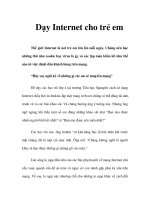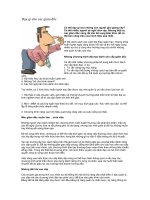Tài liệu Day trading By Douglas E.Zalesky docx
Bạn đang xem bản rút gọn của tài liệu. Xem và tải ngay bản đầy đủ của tài liệu tại đây (121.81 KB, 6 trang )
THE
25-POINT
MANTRA
The success that a trader achieves in the markets is directly correlated to one’s trading
discipline or lack thereof. Trading discipline is 90 percent of the game. The formula is
very simple:Trade with discipline and you will succeed;trade without discipline and you
will fail.
I have been a trader and member of the Chicago Board of Trade (CBOT) for 20 years.
During my successful pit-trading career as a scalper, I traded in three different contract
markets: 30-Year Treasury bonds at the CBOT, the S&P 500 at the Chicago Mercantile
Exchange (CME) and the Gilts at the London International Financial Futures Exchange
(LIFFE). Currently, I also trade the electronic $5 Dow futures contract on the CBOT as
time permits.
Although my formal academic education consists of a bachelor’s degree in business
administration from the University of Denver, I never considered myself to be an
extremely gifted student. I have no formal training in market technical analysis. I’m
unable to even set up a Fibonacci study or Moving Average study on a charting pack-
age,let alone know how to trade with such data.I have no formal training in market fun-
damental analysis. I don’t understand the economic causal relationship between the
actions of the Federal Open Market Committee and Treasury bond prices or equity
prices.
How, then, have I been able to succeed, day after day, trading the markets for more than
20 years? The answer is simple: I trade with discipline, and I respect the market. When
I’m wrong I get out immediately, and when I’m right, I don’t get too greedy. I’m content
with small winners and I’m accepting of small losers.
Just as I now mentor my trading clients regarding performance, discipline and
profit/loss management, I was mentored by one of the best traders ever to set foot on
the CBOT trading floor, David Goldberg. David was a long-time spread scalper in the
wheat pit and a principal of Goldberg Bros., at the time one of the largest clearing firms
at the CBOT, CME and Chicago Board Options Exchange (CBOE). David taught me the
rules of trading discipline. I listened to his guidance and gradually, over time, became
more and more successful.The student has now become the teacher.
discipline for
Provided by permission of SFO Magazine February 2003. © 2003 Wasendorf & Associates, Inc. • 3812 Cedar Heights Drive • Cedar Falls, IA 50613
day trading
By Douglas E. Zalesky
Precise Trading Feature
Provided by permission of SFO Magazine February 2003. © 2003 Wasendorf & Associates, Inc. • 3812 Cedar Heights Drive • Cedar Falls, IA 50613
We have all violated this rule.
However, it should be our goal
to try harder not to violate it in
the future. What we are really
talking about here is the greed factor.
The market has rewarded you by moving in the direction of your posi-
tion, however, you are not satisfied with a small winner. Thus you hold
onto the trade in the hopes of a larger gain, only to watch the market
turn and move against you. Of course, inevitably you now hesitate and
the trade further deteriorates into a substantial loss.
There’s no need to be greedy. It’s only one trade. You’ll make many
more trades throughout the session and many more throughout the
next trading sessions. Opportunity exists in the marketplace all of the
time. Remember: No one trade should make or break your perform-
ance for the day. Don’t be greedy.
All good traders follow this rule.
Why continue to lose on five lots
(contracts) per trade when you
could save yourself a lot of
money by lowering your trade
size down to a one lot on your
next trade? If I have two losing
trades in a row, I always lower my trade
size down to a one lot. If my next two trades are profitable, then I
move my trade size back up to my original lot size.
It’s like a batter in baseball who has struck out his last two times at bat.
The next time up he will choke up on the bat, shorten his swing and
try to make contact. Trading is the same: lower your trade size, try to
make a tick or two — or even scratch the trade — and then raise your
trade size after two consecutive winning trades.
Being disciplined is
of the utmost
importance, but
it’s not a some-
times thing, like
claiming you quit
a bad habit, such as
smoking. If you
claim to quit smoking
but you sneak a cigarette every
once in a while, then you clearly have not quit smoking. If you trade
with discipline nine out of ten trades, then you can’t claim to be a dis-
ciplined trader. It is the one undisciplined trade that will really hurt
your overall performance for the day. Discipline must be practiced on
every trade.
When I state that “the market will reward you,” typically it is in rec-
ognizing less of a loss on a losing trade than if you were stubborn and
held on too long to a bad trade. Thus, if I lose $200 on a trade, but I
would have lost $1,000 if I had remained in that losing trade, I can
claim that I “saved” myself $800 in additional losses by exiting the
bad trade with haste.
Trading with discipline will put
more money in your pocket and
take less money out. The one
constant truth concerning the
markets is that discipline =
increased profits.
The Wheel of Success
There are three spokes that make up, what I call the “Wheel of Success”
as it relates to trading. The first spoke is content. Content consists of
all the external and internal market information that traders utilize
to make their trading decisions. All traders must purchase
value-added content that provides utility in making
their trading decisions.
The most important type of content is internal
market information (IMI). IMI simply is time
and price information as disseminated by the
exchanges. After all, we all make our trading
decisions in the present tense based on time
and price. In order to “scalp” the markets
effectively, we must have the most live and
up-to-date time and price information seam-
lessly delivered to our PCs through a reliable
execution platform and/or charting package.
Without instantaneous time and price informa-
tion, we would be trading in the dark.
The second spoke is mechanics. Mechanics is how you
access the markets and the methodology that you employ to
enter/exit your trades. You must master mechanics before you can
enjoy any success as a trader. A simple keystroke error can result in a
loss of thousands of dollars. A trader can ruin his entire day with an
inadvertent trade entry error.
Once you have mastered order execution, though, it is like riding a
bike. The process of entering and exiting trades becomes seam-
less and mindless. Fast and efficient trade execution, espe-
cially if you are trading with a scalping methodology,
will enable you to hit a bid or take an offer before
your competitors do. Remember, the fastest sur-
vive.
The third and most important spoke in the
Wheel of Success is discipline. You must
attain discipline if you ever hope to achieve
any level of trading success. Trading disci-
pline is practiced 100 percent of the time,
every trade, every day.
Review the following 25 Rules of Trading
Discipline. You must condition yourself to
behave with discipline over and over again. Many
of my traders and clients read through the rules every
day (believe it or not) before the trading session begins.
It doesn’t take more than three minutes to read through them.
Think of the exercise as praying — reminding you how to conduct
yourself throughout the trading session.
THE MARKET
PAYS YOU
TO BE
DISCIPLINED.
1
#
BE DISCIPLINED
EVERY DAY, IN EVERY
TRADE, AND THE MARKET
WILL REWARD YOU. BUT
DON’T CLAIM TO BE
DISCIPLINED IF YOU ARE
NOT 100 PERCENT
OF THE TIME.
2
#
ALWAYS
LOWER YOUR
TRADE SIZE
WHEN YOU’RE
TRADING
POORLY.
3
#
NEVER TURN A
WINNER INTO A
LOSER.
4
#
discipline
mechanics
content
Provided by permission of SFO Magazine February 2003. © 2003 Wasendorf & Associates, Inc. • 3812 Cedar Heights Drive • Cedar Falls, IA 50613
When I was a new
and undisciplined
trader, I can’t tell you
how many times that I
prayed to the “Bond god.” My
prayers were a plea to help me out of a less-than-pleasant trade posi-
tion. I would pray for some sort of divine intervention that, by the
way, never materialized. I soon realized that praying to the “Bond
god” or any other “futures god” was a wasted exercise. Just get out!
Once you come to the realization
that your trade is no good it’s best
to exit immediately. “It’s never a
loser until you get out” and “Not to
worry, it’ll come back” are often said
tongue in cheek, by traders in the pit. Once the phrase is stated, it is an
affirmation that the trader realizes that the trade is no good, it is not
coming back and it is time to exit.
You are not a “loser” because
you have a losing trade on.
You are, however, a loser if
you do not get out of the losing
trade once you recognize that the trade is no
good. It’s amazing to me how accurate your gut is as a market indica-
tor. If, in your gut, you have the idea that the trade is no good then it’s
probably no good. Time to exit.
Every trader has losing trades throughout the session. A typical trade
day for me consists of 33 percent losing trades, 33 percent scratches
and 33 percent winners. I exit my losers very quickly. They don’t cost
me much. So, although I have either lost or scratched over two-thirds
of my trades for the day, I still go home a winner.
Too many new traders think that
because they have $25,000
equity in their trading account
that they somehow have the
right to trade five or ten e-Mini S&P
contracts. This cannot be further from the truth. If you can’t trade a
one lot successfully, what makes you
think that you have the right to trade a
10 lot?
I demand that my students show me a
trading profit over the course of ten
consecutive trading days trading a
one lot only. When they have
achieved a profitable ten-day period,
in my eyes, they have earned the right
to trade a two lot for the next ten trad-
ing sessions.
Remember: if you are trading poorly
with two lots you must lower your
trade size down to a one lot.
Never put yourself in the pre-
carious position of losing
more money than you can
afford. The worst feeling in
the world is wanting to trade
and not being able to do so
because the equity in your account
is too low and your brokerage firm will not allow you to continue
unless you submit more funds.
I require my students to place daily downside limits on their perform-
ance. For example, your daily loss limit can never exceed $500. Once
you reach the $500 loss limit, you must turn your PC off and call it a
day. You can always come back tomorrow.
In all of my years as a trader
I never traded more than a
50 lot on any individual
trade. Sure, I would have
liked to be able to trade like col-
leagues in the pit who were regularly trading 100 or 200 lots per trade.
However, I didn’t possess the emotional or psychological skill set nec-
essary to trade such big size. That’s OK. I knew that my comfort zone
was somewhere between 10 and 20 lots per trade. Typically, if I trad-
ed more than 20 lots, I would “butcher” the trade. Emotionally I could
not handle that size. The trade would inevitably turn into a loser
because I could not trade with the same talent level that I possessed
with a 10 lot.
Learn to accept your comfort zone as it relates to trade size. You are
who you are.
I require my “students” to actu-
ally write down the specific
market prerequisites (set-
ups) that must take place in
order for them to make a
trade. I don’t necessarily
care what the methodology is,
but I do want them to make sure
that they have a set of rules, market set-
ups or price action that must appear in order for them to take the trade.
You must have a game plan.
If you have a proven methodology but it doesn’t seem to be working
in a given trading session, don’t go home that night and try to devise
another one. If your methodology works more than one-half of the
trading sessions, then stick with it.
Keep a trade log of all your trades
throughout the session. If, for
example, you know that, so far,
your biggest winner on the day
is five e-Mini S&P points, then do
not allow a losing trade to exceed those
five points. If you do allow a loss to exceed your biggest gain then,
effectively, what you have when you net out the biggest winner and
biggest loss is a net loss on the two trades. Not good.
YOUR BIGGEST
LOSER CAN’T
EXCEED YOUR
BIGGEST
WINNER.
5
#
DEVELOP A
METHODOLOGY
AND STICK WITH IT.
DON’T CHANGE
METHODOLOGIES
FROM DAY
TO DAY.
6
#
BE YOURSELF.
DON’T TRY TO BE
SOMEONE ELSE.
7
#
YOU ALWAYS
WANT TO BE ABLE
TO COME BACK
AND PLAY THE
NEXT DAY.
8
#
EARN THE
RIGHT TO TRADE
BIGGER.
9
#
GET OUT OF
YOUR LOSERS.
10
#
11
#
DON’T HOPE AND
PRAY. IF YOU DO,
YOU WILL LOSE.
12
#
If you have a
proven
methodology
but it doesn’t
seem to be
working in a
given trading
session, don’t
go home that
night and try
to devise
another one.
THE FIRST
LOSS IS THE
BEST LOSS.
Precise Trading Feature
Provided by permission of SFO Magazine February 2003. © 2003 Wasendorf & Associates, Inc. • 3812 Cedar Heights Drive • Cedar Falls, IA 50613
I have never understood why
so many electronic traders
listen to or watch CNBC,
MSNBC, Bloomberg News or
FNN all day long. The “talking
heads” on these programs know very little about market dynamics and
market price action. Very few, if any, have ever even traded a one lot
in any pit on any exchange. Yet they claim to be experts on everything.
Before becoming a “trading and markets expert,” the guy on CNBC
reporting hourly from the Bond Pit, was a phone clerk on the trading
floor. Obviously this qualifies him to be an expert! He, and others, can
provide no utility to you. Treat it for what it really is…. entertainment.
The fact is: The reporting that you hear on the business programs is
“old news.” The story has already been dissected and consumed by the
professional market participants long before the “news” has been dis-
seminated. Do not trade off of the reporting. It’s too late.
In all of the years that
I have been a trader
and associated with
traders, I have never met a
successful speculator. It is impossible to speculate and consistently
print large winners. Don’t be a speculator. Be a trader.
Short-term scalping of the markets is the answer. The probability of a
winning day or week is greatly increased if you trade short term: small
winners and even smaller losses.
This rule is the one that I get
the most questions and feed-
back on by traders from all
over the world. Traders ask,
“What do you mean, love to lose money. Are you crazy?”
No, I’m not crazy. What I mean is to accept the fact that you are going
to have losing trades throughout the trading session. Get out of your
losers quickly. Love to get out of your losers quickly. It will save you
a lot of trading capital and will make you a much better trader.
This rule relates to the
theory of capital
flow. It is trading
capital that pushes a
market one way or
another. An oversupply or
imbalance of buy orders will push the
market up. An oversupply of sell orders will push the market lower.
When price stagnation is present (as typically happens many times
throughout the trading session), the market and its participants are
telling us that, at the present time, they are happy or satisfied with the
prevailing bid and offer.
You don’t want to be in the market at these times. The market is not going
anywhere. It is a waste of time, capital and emotional energy. It’s much
better to wait for the market to heat up a little and then place your trade.
Please review rules #5, #8,
#10, #11 and #15. If you
follow any one of these
rules you will never violate
rule #17.
Big losses prevent you from having a winning day. They wipe out too
many small winners that you have worked so hard to achieve. Big
losses also “kill you” from a psychological and emotional standpoint.
It takes a long time to get your confidence back after taking a big loss
on a trade.
When I was a young bond trad-
er, my goal every day was to
make 10 bond tics. A tic is
$31.25, so if I made 10 tics
on the day, I would be up
$312.50.
It may not sound like a lot of money to you, but it surely was to me.
My mentor, David Goldberg, told me that if I could make 10 bond tics
every trading day of the year, at the end of the year I would be up
$72,500 in my trading account. Not bad for a 23-year old kid in 1982.
It is amazing how quickly your trading account will build up over time
just by making a little bit every day. If you are a new e-Mini S&P trad-
er try to make just 5 or 6 points per day. If you can do that you’ll have
that $72,000 at the end of the year.
Just as I don’t know of
any successful specu-
lators, I don’t know of
any trader who goes into a
trade expecting to hit a home run and then actually having it happen.
You should never approach a trade with the idea that it’s going to be a
huge winner. Sometimes they turn out that way, but the times that I have
a hit a home run on a position is most definitely luck, not skill.
My intent on the trade was to produce a small winner but, because I
had the trade on, and at the same time (as luck would have it), the Fed
unexpectedly entered the market, I unwittingly had a huge winner.
This probably has happened to me less than five times in 20 years.
How nice is it to be
able to turn on
your PC in the
morning knowing
that if you play by the
Rules, trade with discipline and stick to your methodology, the proba-
bility of a successful day is high.
I’ve had years where I could count on one hand the number of losing
days that I had. Don’t you think that this consistency allowed me to be
extremely confident? I knew that I was going to make money on any
given day. Why would I think otherwise? Making a little bit everyday
(Rules #18 and #19) will allow you to trade throughout the trading ses-
sion with confidence and control.
Remember Rule #9: If you make a little bit every day, then you have
earned the right to trade bigger. Thus, by following the Rules of
Discipline, your “little bit” can soon turn into much more profitable days.
DON’T WORRY
ABOUT NEWS.
IT’S HISTORY.
13
#
DON’T SPECULATE.
IF YOU DO, YOU
WILL LOSE.
14
#
LOVE TO LOSE
MONEY.
15
#
IF YOUR TRADE
IS NOT GOING ANY-
WHERE IN A GIVEN
TIMEFRAME, IT’S
TIME TO EXIT.
16
#
NEVER TAKE
A BIG LOSS. ONLY
A BIG LOSS CAN
HURT YOU.
17
#
MAKE A
LITTLE BIT
EVERYDAY. DIG
YOUR DITCHES.
DON’T FILL
THEM IN.
18
#
HIT SINGLES
NOT HOME RUNS.
19
#
CONSISTENCY
BUILDS CONFIDENCE
AND CONTROL.
20
#
Provided by permission of SFO Magazine February 2003. © 2003 Wasendorf & Associates, Inc. • 3812 Cedar Heights Drive • Cedar Falls, IA 50613









